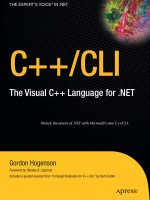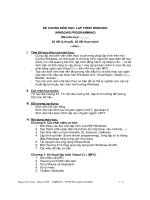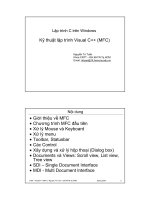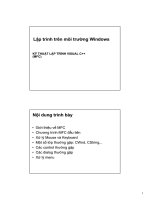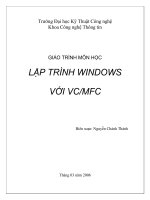Visual c# 2012
Bạn đang xem bản rút gọn của tài liệu. Xem và tải ngay bản đầy đủ của tài liệu tại đây (16.82 MB, 910 trang )
ffirs.indd iffirs.indd i 17/11/12 10:46 AM17/11/12 10:46 AM
BEGINNING VISUAL C#® 2012 PROGRAMMING
INTRODUCTION . . . . . . . . . . . . . . . . . . . . . . . . . . . . . . . . . . . . . . . . . . . . . . . . . . . . . . . . . . . .xxxi
PART I THE C# LANGUAGE
CHAPTER 1 Introducing C# . . . . . . . . . . . . . . . . . . . . . . . . . . . . . . . . . . . . . . . . . . . . . . . . . 3
CHAPTER 2 Writing a C# Program . . . . . . . . . . . . . . . . . . . . . . . . . . . . . . . . . . . . . . . . . . .13
CHAPTER 3 Variables and Expressions . . . . . . . . . . . . . . . . . . . . . . . . . . . . . . . . . . . . . . 25
CHAPTER 4 Flow Control . . . . . . . . . . . . . . . . . . . . . . . . . . . . . . . . . . . . . . . . . . . . . . . . . . 49
CHAPTER 5 More About Variables . . . . . . . . . . . . . . . . . . . . . . . . . . . . . . . . . . . . . . . . . . 79
CHAPTER 6 Functions . . . . . . . . . . . . . . . . . . . . . . . . . . . . . . . . . . . . . . . . . . . . . . . . . . . . 105
CHAPTER 7 Debugging and Error Handling . . . . . . . . . . . . . . . . . . . . . . . . . . . . . . . . . . 131
CHAPTER 8 Introduction to Object-Oriented Programming . . . . . . . . . . . . . . . . . . . 157
CHAPTER 9 Defi ning Classes . . . . . . . . . . . . . . . . . . . . . . . . . . . . . . . . . . . . . . . . . . . . . . .177
CHAPTER 10 Defi ning Class Members . . . . . . . . . . . . . . . . . . . . . . . . . . . . . . . . . . . . . . . 203
CHAPTER 11 Collections, Comparisons, and Conversions . . . . . . . . . . . . . . . . . . . . . 235
CHAPTER 12 Generics . . . . . . . . . . . . . . . . . . . . . . . . . . . . . . . . . . . . . . . . . . . . . . . . . . . . . 279
CHAPTER 13 Additional OOP Techniques . . . . . . . . . . . . . . . . . . . . . . . . . . . . . . . . . . . . 313
CHAPTER 14 C# Language Enhancements . . . . . . . . . . . . . . . . . . . . . . . . . . . . . . . . . . . 339
PART II WINDOWS PROGRAMMING
CHAPTER 15 Basic Desktop Programming . . . . . . . . . . . . . . . . . . . . . . . . . . . . . . . . . . . 381
CHAPTER 16 Advanced Desktop Programming . . . . . . . . . . . . . . . . . . . . . . . . . . . . . . . 425
CHAPTER 17 Windows Store Apps . . . . . . . . . . . . . . . . . . . . . . . . . . . . . . . . . . . . . . . . . . 469
CHAPTER 18 Deploying Desktop Applications . . . . . . . . . . . . . . . . . . . . . . . . . . . . . . . 513
PART III WEB PROGRAMMING
CHAPTER 19 ASP.NET Web Programming . . . . . . . . . . . . . . . . . . . . . . . . . . . . . . . . . . . 535
CHAPTER 20 Deploying Web Applications . . . . . . . . . . . . . . . . . . . . . . . . . . . . . . . . . . . 591
Continued
ffirs.indd iffirs.indd i 17/11/12 10:46 AM17/11/12 10:46 AM
PART IV DATA ACCESS
CHAPTER 21 File System Data. . . . . . . . . . . . . . . . . . . . . . . . . . . . . . . . . . . . . . . . . . . . . .605
CHAPTER 22 XML . . . . . . . . . . . . . . . . . . . . . . . . . . . . . . . . . . . . . . . . . . . . . . . . . . . . . . . . . 639
CHAPTER 23 Introduction to LINQ . . . . . . . . . . . . . . . . . . . . . . . . . . . . . . . . . . . . . . . . . . 663
CHAPTER 24 Applying LINQ . . . . . . . . . . . . . . . . . . . . . . . . . . . . . . . . . . . . . . . . . . . . . . . 699
PART V ADDITIONAL TECHNIQUES
CHAPTER 25 Windows Communication Foundation . . . . . . . . . . . . . . . . . . . . . . . . . . . 727
CHAPTER 26 Windows Workfl ow Foundation. . . . . . . . . . . . . . . . . . . . . . . . . . . . . . . . . 759
APPENDIX A Exercise Solutions . . . . . . . . . . . . . . . . . . . . . . . . . . . . . . . . . . . . . . . . . . . .779
INDEX . . . . . . . . . . . . . . . . . . . . . . . . . . . . . . . . . . . . . . . . . . . . . . . . . . . . . . . . . . . . . . . . . . . . . 827
ffirs.indd iiffirs.indd ii 17/11/12 10:46 AM17/11/12 10:46 AM
BEGINNING
Visual C#® 2012 Programming
ffirs.indd iiiffirs.indd iii 17/11/12 10:46 AM17/11/12 10:46 AM
ffirs.indd ivffirs.indd iv 17/11/12 10:46 AM17/11/12 10:46 AM
BEGINNING
Visual C#® 2012 Programming
Karli Watson
Jacob Vibe Hammer
John D. Reid
Morgan Skinner
Daniel Kemper
Christian Nagel
ffirs.indd vffirs.indd v 17/11/12 10:46 AM17/11/12 10:46 AM
Beginning Visual C#® 2012 Programming
Published by
John Wiley & Sons, Inc.
10475 Crosspoint Boulevard
Indianapolis, IN 46256
www.wiley.com
Copyright © 2013 by John Wiley & Sons, Inc., Indianapolis, Indiana
Published simultaneously in Canada
ISBN: 978-1-118-31441-8
ISBN: 978-1-118-33194-1 (ebk)
ISBN: 978-1-118-33540-6 (ebk)
ISBN: 978-1-118-39637-7 (ebk)
Manufactured in the United States of America
10 9 8 7 6 5 4 3 2 1
No part of this publication may be reproduced, stored in a retrieval system or transmitted in any form or by any means,
electronic, mechanical, photocopying, recording, scanning or otherwise, except as permitted under Sections 107 or 108
of the 1976 United States Copyright Act, without either the prior written permission of the Publisher, or authorization
through payment of the appropriate per-copy fee to the Copyright Clearance Center, 222 Rosewood Drive, Danvers,
MA 01923, (978) 750-8400, fax (978) 646-8600. Requests to the Publisher for permission should be addressed to the
Permissions Department, John Wiley & Sons, Inc., 111 River Street, Hoboken, NJ 07030, (201) 748-6011,
fax (201) 748-6008, or online at />Limit of Liability/Disclaimer of Warranty: The publisher and the author make no representations or warranties with
respect to the accuracy or completeness of the contents of this work and speci cally disclaim all warranties, including
without limitation warranties of tness for a particular purpose. No warranty may be created or extended by sales or
promotional materials. The advice and strategies contained herein may not be suitable for every situation. This work is
sold with the understanding that the publisher is not engaged in rendering legal, accounting, or other professional
services. If professional assistance is required, the services of a competent professional person should be sought. Neither
the publisher nor the author shall be liable for damages arising herefrom. The fact that an organization or Web site is
referred to in this work as a citation and/or a potential source of further information does not mean that the author or the
publisher endorses the information the organization or Web site may provide or recommendations it may make. Further,
readers should be aware that Internet Web sites listed in this work may have changed or disappeared between when this
work was written and when it is read.
For general information on our other products and services please contact our Customer Care Department within the
United States at (877) 762-2974, outside the United States at (317) 572-3993 or fax (317) 572-4002.
Wiley publishes in a variety of print and electronic formats and by print-on-demand. Some material included with
standard print versions of this book may not be included in e-books or in print-on-demand. If this book refers to media
such as a CD or DVD that is not included in the version you purchased, you may download this material at
. For more information about Wiley products, visit www.wiley.com.
Library of Congress Control Number: 2012946841
Trademarks: Wiley, the Wiley logo, Wrox, the Wrox logo, Wrox Programmer to Programmer, and related trade dress
are trademarks or registered trademarks of John Wiley & Sons, Inc. and/or its af liates, in the United States and
other countries, and may not be used without written permission. Visual C# is a registered trademark of Microsoft
Corporation. All other trademarks are the property of their respective owners. John Wiley & Sons, Inc., is not associated
with any product or vendor mentioned in this book.
ffirs.indd viffirs.indd vi 17/11/12 10:46 AM17/11/12 10:46 AM
for donna
— K W
Love is as strong as death;
Many waters cannot quench love,
neither can the oods drown it.
From the inside of my Mum’s hymnbook, of which I
now have the privilege of being the custodian.
— M S
ffirs.indd viiffirs.indd vii 17/11/12 10:46 AM17/11/12 10:46 AM
ffirs.indd viiiffirs.indd viii 17/11/12 10:46 AM17/11/12 10:46 AM
ABOUT THE AUTHORS
KARLI WATSON is an IT contractor and author currently working in London in the nancial sector. For the
most part, he immerses himself in .NET (in particular C#) and has written numerous books in the eld for
several publishers. He specializes in communicating complex ideas in a way that is accessible to anyone with
a passion to learn, and spends much of his time playing with new technology to nd new things to teach
people about.
During those (seemingly few) times where he isn’t doing the above, Karli will probably be wishing he was
hurtling down a mountain on a snowboard. Or possibly trying to get his novel published. Either way, you’ll
know him by his brightly colored clothes. You can also nd him tweeting online as @karlequin, and maybe
one day he’ll get round to making himself a website.
JACOB VIBE HAMMER is a software architect and developer at Kamstrup, where he is helping the company
develop world class Smart Grid solutions for large public utilities. He started programming just about the
time when he was able to spell the word “BASIC” — which, incidentally, is the rst programming language
he ever used. Since then, he has worked with numerous programming languages and solution architectures;
however, since the turn of the century, he has worked primarily with the .NET platform. Today, his pro-
gramming time is spent working primarily with C# and WPF, as well as toying with NoSQL databases.
A Danish citizen, Jacob lives in Aarhus, Denmark, with his wife and son.
JON D. REID is the Director of Software Technology for IFS Metrix Service Management (www.IFSWORLD
.com/Metrix
). He has coauthored a number of .NET books, including Beginning Visual C# 2010, Fast
Track C#, Pro Visual Studio .NET, and many others.
MORGAN SKINNER started messing with computers in 1980 when he rst started programming at school in
assembly language. Since then he’s used many languages commercially, including Pascal, Modula-2, VAX
Macro assembly language, Smalltalk, PowerBuilder, C, C++ and C# (to name the more well-known ones). He
joined Microsoft in 2001 after getting his hands on .NET for the rst time, and he spent nearly 10 years there
as an Application Development Consultant, working with some of the smallest — and largest — companies in
the UK. Morgan left Microsoft in 2011 and is now an independent contractor working on bespoke systems;
see www.morganskinner.com for more details.
DANIEL KEMPER is a software architect with a couple of Microsoft certi cations. He specializes in rich
Internet application, desktop client, and reporting technologies.
CHRISTIAN NAGEL is a Microsoft Regional Director and Microsoft MVP, an associate of thinktecture, and
founder of CN innovation. A software architect and developer, he offers training and consulting on how to
develop solutions using the Microsoft platform. He draws on more than 25 years of software development
experience. Christian started his computing career with PDP 11 and VAX/VMS systems, covering a variety
of languages and platforms. Since 2000, when .NET was just a technology preview, he has been working
with various .NET technologies to build .NET solutions. Currently, he mainly coaches the development of
Windows 8 apps accessing Windows Azure services. With his profound knowledge of Microsoft technologies,
he has written numerous books and is certi ed as a Microsoft Certi ed Trainer and Professional Developer.
Christian speaks at international conferences such as TechEd, Basta!, and TechDays, and he founded INETA
Europe to support .NET user groups. You can contact Christian via his websites, www.cninnovation.com
and www.thinktecture.com. You can also follow his tweets at @christiannagel.
ffirs.indd ixffirs.indd ix 17/11/12 10:46 AM17/11/12 10:46 AM
ABOUT THE TECHNICAL EDITORS
DOUG HOLLAND is an architect with Microsoft’s Developer and Platform Evangelism team and works with
Microsoft’s strategic ISV partners to help bring new and exciting experiences to consumers on Windows 8
and Windows Phone 8.
RICHARD HOPTON has been developing business software systems for 10 years, currently focusing on
designing and building highly scalable REST-based API solutions using C# for a digital media company in
London, UK. Richard has been published in Microsoft’s monthly developer newsletter, MSDN Flash, and
has spoken at numerous developer community events throughout the UK.
MARCEL MEIJER has lived in the world of information and communications technologies for more than
15 years. Currently, he is mainly concerned with Windows Azure, the cloud, C#, software development, and
architecture. He works as a senior architect at VX Company. In his spare time, he is a board member of the
SDN (Software Development Network; www.sdn.nl). At SDN, he is responsible for arranging speakers for
the SDN Events (SDE); selecting content for SDN Conferences; and arranging and editing content for SDN
Magazine.
ffirs.indd xffirs.indd x 17/11/12 10:46 AM17/11/12 10:46 AM
CREDITS
ACQUISITIONS EDITOR
Mary James
PROJECT EDITOR
Patrick Meader
TECHNICAL EDITORS
Doug Holland
Richard Hopton
Marcel Meijer
PRODUCTION EDITOR
Christine Mugnolo
COPY EDITOR
Kezia Endsley
EDITORIAL MANAGER
Mary Beth Wakefi eld
FREELANCER EDITORIAL MANAGER
Rosemarie Graham
ASSOCIATE DIRECTOR OF MARKETING
David Mayhew
MARKETING MANAGER
Ashley Zurcher
BUSINESS MANAGER
Amy Knies
PRODUCTION MANAGER
Tim Tate
VICE PRESIDENT AND EXECUTIVE GROUP
PUBLISHER
Richard Swadley
VICE PRESIDENT AND EXECUTIVE PUBLISHER
Neil Edde
ASSOCIATE PUBLISHER
Jim Minatel
PROJECT COORDINATOR, COVER
Katie Crocker
PROOFREADERS
Sarah Kaikini, Word One New York
Scott Klemp, Word One New York
James Saturnio, Word One New York
INDEXER
Robert Swanson
COVER DESIGNER
LeAndra Young
COVER IMAGE
© Lisa Loyd / iStockphoto
ffirs.indd xiffirs.indd xi 17/11/12 10:46 AM17/11/12 10:46 AM
ffirs.indd xiiffirs.indd xii 17/11/12 10:46 AM17/11/12 10:46 AM
ACKNOWLEDGMENTS
THANKS ONCE AGAIN TO EVERYONE AT WILEY for help, encouragement, and understanding. Striking the
balance between getting the book done quickly and ensuring it’s accurate in the face of numerous product
and naming changes is never easy, but between us I think we’ve just about managed it. Special thanks to
Patrick Meader for remaining (mostly) calm throughout the project — or at least calmer than me… As ever,
no acknowledgements would be complete without thanks to my wife, donna, who very nearly succeeds in
keeping me sane during writing periods. And, of course, thanks to you for (hopefully) buying this book, and
the very best of luck in your coding adventures!
— K W
ffirs.indd xiiiffirs.indd xiii 17/11/12 10:46 AM17/11/12 10:46 AM
ffirs.indd xivffirs.indd xiv 17/11/12 10:46 AM17/11/12 10:46 AM
CONTENTS
INTRODUCTION xxxi
PART I: THE C# LANGUAGE
CHAPTER 1: INTRODUCING C# 3
What Is the .NET Framework? 3
What’s in the .NET Framework? 4
Writing Applications Using the .NET Framework 4
CIL and JIT 4
Assemblies 5
Managed Code 5
Garbage Collection 6
Fitting It Together 6
Linking 7
What Is C#? 7
Applications You Can Write with C# 8
C# in this Book 8
Visual Studio 2012 8
Visual Studio Express 2012 Products 9
Solutions 9
Summary 10
CHAPTER 2: WRITING A C# PROGRAM 13
The Visual Studio 2012 Development Environment 14
Console Applications 16
The Solution Explorer 18
The Properties Window 19
The Error List Window 19
Desktop Applications 20
Summary 23
CHAPTER 3: VARIABLES AND EXPRESSIONS 25
Basic C# Syntax 26
Basic C# Console Application Structure 28
Variables 29
Simple Types 29
ftoc.indd xvftoc.indd xv 17/11/12 10:47 AM17/11/12 10:47 AM
xvi
CONTENTS
Variable Naming 33
Naming Conventions 34
Literal Values 34
Variable Declaration and Assignment 36
Expressions 37
Mathematical Operators 37
Assignment Operators 41
Operator Precedence 42
Namespaces 42
Summary 45
CHAPTER 4: FLOW CONTROL 49
Boolean Logic 49
Boolean Assignment Operators 52
Bitwise Operators 53
Operator Precedence Updated 57
The goto Statement 58
Branching 59
The Ternary Operator 59
The if Statement 59
Checking More Conditions Using if Statements 62
The switch Statement 63
Looping 65
do Loops 66
while Loops 68
for Loops 70
Interrupting Loops 74
Infi nite Loops 75
Summary 75
CHAPTER 5: MORE ABOUT VARIABLES 79
Type Conversion 80
Implicit Conversions 80
Explicit Conversions 81
Explicit Conversions Using the Convert Commands 84
Complex Variable Types 86
Enumerations 87
Defi ning Enumerations 87
Structs 90
Defi ning Structs 90
ftoc.indd xviftoc.indd xvi 17/11/12 10:47 AM17/11/12 10:47 AM
xvii
CONTENTS
Arrays 92
Declaring Arrays 93
foreach Loops 95
Multidimensional Arrays 96
Arrays of Arrays 97
String Manipulation 98
Summary 102
CHAPTER 6: FUNCTIONS 105
Defi ning and Using Functions 106
Return Values 108
Parameters 109
Parameter Matching 111
Parameter Arrays 111
Reference and Value Parameters 113
Out Parameters 115
Variable Scope 116
Variable Scope in Other Structures 118
Parameters and Return Values versus Global Data 120
The Main( ) Function 121
Struct Functions 123
Overloading Functions 124
Using Delegates 125
Summary 128
CHAPTER 7: DEBUGGING AND ERROR HANDLING 131
Debugging in Visual Studio 132
Debugging in Nonbreak (Normal) Mode 132
Outputting Debugging Information 133
Tracepoints 137
Diagnostics Output Versus Tracepoints 139
Debugging in Break Mode 140
Entering Break Mode 140
Monitoring Variable Content 142
Stepping Through Code 144
Immediate and Command Windows 146
The Call Stack Window 146
Error Handling 147
try…catch…fi nally 147
Listing and Confi guring Exceptions 152
ftoc.indd xviiftoc.indd xvii 17/11/12 10:47 AM17/11/12 10:47 AM
xviii
CONTENTS
Notes on Exception Handling 152
Summary 153
CHAPTER 8: INTRODUCTION TO OBJECTORIENTED
PROGRAMMING 157
What Is Object-Oriented Programming? 158
What Is an Object? 158
Properties and Fields 159
Methods 160
Everything’s an Object 161
The Life Cycle of an Object 161
Constructors 161
Destructors 162
Static and Instance Class Members 162
Static Constructors 162
Static Classes 163
OOP Techniques 163
Interfaces 163
Disposable Objects 164
Inheritance 165
Polymorphism 167
Interface Polymorphism 168
Relationships Between Objects 168
Containment 168
Collections 169
Operator Overloading 169
Events 170
Reference Types Versus Value Types 170
OOP in Desktop Applications 171
Summary 174
CHAPTER 9: DEFINING CLASSES 177
Class Defi nitions in C# 177
Interface Defi nitions 180
System.Object 182
Constructors and Destructors 184
Constructor Execution Sequence 185
OOP Tools in Visual Studio 188
The Class View Window 188
The Object Browser 190
Adding Classes 191
ftoc.indd xviiiftoc.indd xviii 17/11/12 10:47 AM17/11/12 10:47 AM
xix
CONTENTS
Class Diagrams 192
Class Library Projects 193
Interfaces Versus Abstract Classes 196
Struct Types 198
Shallow Copying Versus Deep Copying 200
Summary 200
CHAPTER 10: DEFINING CLASS MEMBERS 203
Member Defi nitions 203
Defi ning Fields 204
Defi ning Methods 204
Defi ning Properties 205
Adding Members from a Class Diagram 210
Adding Methods 210
Adding Properties 212
Adding Fields 212
Refactoring Members 212
Automatic Properties 213
Additional Class Member Topics 213
Hiding Base Class Methods 213
Calling Overridden or Hidden Base Class Methods 215
The this Keyword 216
Using Nested Type Defi nitions 216
Interface Implementation 218
Implementing Interfaces in Classes 219
Explicit Interface Member Implementation 220
Additional Property Accessors 220
Partial Class Defi nitions 221
Partial Method Defi nitions 222
Example Application 224
Planning the Application 224
The Card Class 224
The Deck Class 224
Writing the Class Library 224
Adding the Suit and Rank Enumerations 225
Adding the Card Class 226
Adding the Deck Class 227
A Client Application for the Class Library 230
The Call Hierarchy Window 231
Summary 232
ftoc.indd xixftoc.indd xix 17/11/12 10:47 AM17/11/12 10:47 AM
xx
CONTENTS
CHAPTER 11: COLLECTIONS, COMPARISONS,
AND CONVERSIONS 235
Collections 236
Using Collections 236
Defi ning Collections 241
Indexers 242
Adding a Cards Collection to CardLib 244
Keyed Collections and IDictionary 247
Iterators 248
Iterators and Collections 252
Deep Copying 253
Adding Deep Copying to CardLib 255
Comparisons 256
Type Comparisons 256
Boxing and Unboxing 257
The is Operator 258
Value Comparisons 260
Operator Overloading 261
Adding Operator Overloads to CardLib 265
The IComparable and IComparer Interfaces 269
Sorting Collections 271
Conversions 274
Overloading Conversion Operators 274
The as Operator 275
Summary 276
CHAPTER 12: GENERICS 279
What Are Generics? 280
Using Generics 281
Nullable Types 281
Operators and Nullable Types 282
The ?? Operator 283
The System.Collections.Generic Namespace 287
List<T> 287
Sorting and Searching Generic Lists 289
Dictionary<K, V> 294
Modifying CardLib to Use a Generic Collection Class 295
Defi ning Generic Types 296
Defi ning Generic Classes 296
The default Keyword 298
ftoc.indd xxftoc.indd xx 17/11/12 10:47 AM17/11/12 10:47 AM
xxi
CONTENTS
Constraining Types 298
Inheriting from Generic Classes 304
Generic Operators 305
Generic Structs 306
Defi ning Generic Interfaces 306
Defi ning Generic Methods 306
Defi ning Generic Delegates 308
Variance 308
Covariance 309
Contravariance 310
Summary 310
CHAPTER 13: ADDITIONAL OOP TECHNIQUES 313
The :: Operator and the Global Namespace Qualifi er 313
Custom Exceptions 315
Adding Custom Exceptions to CardLib 315
Events 316
What Is an Event? 316
Handling Events 317
Defi ning Events 319
Multipurpose Event Handlers 323
The EventHandler and Generic EventHandler<T> Types 325
Return Values and Event Handlers 326
Anonymous Methods 326
Expanding and Using CardLib 327
A Card Game Client for CardLib 327
Attributes 334
Reading Attributes 334
Creating Attributes 335
Summary 336
CHAPTER 14: C# LANGUAGE ENHANCEMENTS 339
Initializers 340
Object Initializers 340
Collection Initializers 342
Type Inference 344
Anonymous Types 346
Dynamic Lookup 350
The dynamic Type 350
IDynamicMetaObjectProvider 354
ftoc.indd xxiftoc.indd xxi 17/11/12 10:47 AM17/11/12 10:47 AM
xxii
CONTENTS
Advanced Method Parameters 354
Optional Parameters 354
Optional Parameter Values 355
The OptionalAttribute Attribute 356
Optional Parameter Order 356
Named Parameters 356
Named and Optional Parameter Guidelines 360
Extension Methods 360
Lambda Expressions 364
Anonymous Methods Recap 364
Lambda Expressions for Anonymous Methods 365
Lambda Expression Parameters 368
Lambda Expression Statement Bodies 368
Lambda Expressions as Delegates and Expression Trees 369
Lambda Expressions and Collections 370
Caller Information Attributes 372
Summary 375
PART II: WINDOWS PROGRAMMING
CHAPTER 15: BASIC DESKTOP PROGRAMMING 381
XAML 382
Separation of Concerns 382
XAML in Action 383
Namespaces 383
Code-Behind Files 384
The Playground 384
WPF Controls 385
Properties 386
Dependency Properties 387
Attached Properties 388
Events 388
Handling Events 389
Routed Events 390
Routed Commands 390
Control Types 392
Control Layout 393
Stack Order 393
Alignment, Margins, Padding, and Dimensions 393
Border 394
Canvas 394
ftoc.indd xxiiftoc.indd xxii 17/11/12 10:47 AM17/11/12 10:47 AM
xxiii
CONTENTS
DockPanel 395
StackPanel 397
WrapPanel 398
Grid 398
The Game Client 401
The About Window 401
Designing the User Interface 401
The Image Control 401
The Label Control 402
The TextBlock Control 402
The Button Control 402
The Options Window 405
The TextBox Control 406
The CheckBox Control 406
The RadioButton Control 407
The ComboBox Control 408
The TabControl 409
Handling Events in the Options Window 411
Data Binding 413
The DataContext 414
Binding to Local Objects 414
Static Binding to External Objects 414
Dynamic Binding to External Objects 415
Starting a Game 418
The ListBox Control 418
Summary 421
CHAPTER 16: ADVANCED DESKTOP PROGRAMMING 425
The Main Window 425
The Menu Control 426
Routed Commands with Menus 426
Creating and Styling Controls 429
Styles 430
Templates 430
Value Converters 434
The IValueConverter Interface 434
ValueConversionAttribute 434
Triggers 435
Animations 436
Timelines without Key Frames 436
Timelines with Key Frames 437
ftoc.indd xxiiiftoc.indd xxiii 17/11/12 10:47 AM17/11/12 10:47 AM
